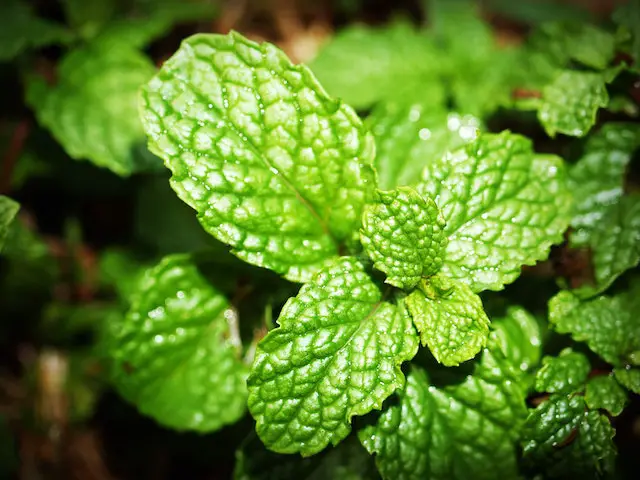Have you ever wondered why does mint taste bitter? Although mint is usually associated with a sweet and refreshing taste, some people experience a bitter aftertaste.
This phenomenon can be confusing, so in this blog post, I’ll be exploring why mint tastes bitter and the potential reasons behind it. You might be surprised by the answer!
The science behind why mint tastes bitter
Mint’s bitter taste comes from the chemical compound menthol.
This natural compound is found in many varieties of mint, such as peppermint and spearmint.
It gives the plant its distinct flavor and odor. Menthol has a cooling effect on the tongue and makes the flavor more intense.
The bitterness in mint comes from the menthol acting as an irritant to the taste buds.
It is an organic compound made up of carbon, hydrogen, and oxygen molecules, which have a cooling and numbing effect on the tongue.
When menthol molecules come into contact with the taste buds, they react to create a bitter flavor.
The amount of menthol present in different types of mint can vary, which is why some types of mint may be more bitter than others.
Peppermint, for example, contains a higher concentration of menthol than spearmint, making it more intensely flavored and slightly more bitter.
The bitterness of mint is also affected by how much sugar or other sweeteners are added.
The sweetness balances out some bitter notes in the menthol, making the flavor more palatable.
In addition, when cooked or dried, some menthol will be lost, leading to a less intense flavor.
Overall, mint’s bitterness comes from the natural menthol compound found within the leaves. While some types of mint are more bitter than others, you can use sweeteners or cooking to reduce the bitterness.
The difference between different types of mint
When it comes to understanding why mint tastes bitter, it’s important to recognize that not all mints are created equal.
There are dozens of varieties of mint, each with its own unique flavor profile.
For instance, spearmint is one of the most popular types of mint and has a light, sweet flavor. On the other hand, peppermint has a much stronger flavor, with a strong menthol taste.
While there are many types of mint, they all contain the same type of compound, menthol.
Menthol is a natural compound found in the essential oils of mint plants, which gives plants their distinctive taste. It’s this compound that makes mint taste bitter.
However, not all types of mint have the same level of menthol.
For instance, peppermint tends to be much stronger than spearmint due to the higher concentration of menthol in the leaves. This means that when using peppermint in recipes or drinks, it’s important to remember that a little goes a long way.
Additionally, some mint varieties can be more bitter than others. Peppermint is often considered to be the bitterest type of mint, while lemon balm and apple mint are known for being milder and sweeter.
This means that if you’re looking for a less bitter flavor, these types may be better suited for your recipe.
Ultimately, understanding the difference between different types of mint can help you create dishes that balance both the bitterness and sweetness of the mint.
By knowing which types are best suited for what you’re making, you can ensure that your dish turns out exactly how you want it to!
How to use mint to combat bitterness
Mint is typically used to combat bitterness in a variety of foods. There are a few ways that you can use mint to reduce the bitter taste of foods.
First, you can steep mint in hot water and then strain the liquid before adding it to recipes.
This will help to extract the flavor of the mint without adding too much bitterness. You can also infuse mint into oil, butter, or other fats to make sauces and dressings that are both flavorful and not overly bitter.
Second, you can add chopped fresh mint leaves to dishes that need some extra flavor and sweetness. Mint leaves can be added at any stage of cooking, or can be used as a garnish after cooking.
You can also combine chopped mint with other herbs, spices, and seasonings to create a well-balanced flavor profile for a dish.
Finally, you can add sugar to dishes that contain mint to help balance out the bitterness. Mint works especially well with sugar when used in desserts like cakes, cookies, and pies. It’s important to add the sugar gradually and taste as you go so that you don’t end up with a dish that is too sweet.
Using mint to combat bitterness is a great way to add a burst of flavor to your dishes without having to rely on heavy seasonings or too much sugar.
With a bit of experimentation, you should be able to find the perfect balance of sweet and savory in no time.
 .
.Tips for using mint to make your food more palatable
Mint has been used for centuries to make food more palatable, but there are a few tips and tricks to get the most out of your minty flavors.
Chop the mint leaves finely
This allows more of the essential oils to be released, intensifying the flavor.
Crush the leaves with a mortar and pestle
This is especially effective if you’re using fresh mint leaves. The crushing action releases the essential oils, making the flavor even more intense.
Use fresh mint leaves whenever possible
Fresh mint leaves have a much stronger flavor than dried, and will add more flavor to your dishes.
Add mint at the end of cooking
If you’re adding mint to a hot dish, add it right at the end to preserve its flavor. Adding it too early can cause it to lose some of its flavor.
Use different types of mint
Different types of mint have different flavors and levels of bitterness. Experimenting with different types of mint can give you the flavor that you’re looking for.
Balance the mint with other flavors
Adding other flavors such as honey or citrus can help to balance out the bitterness of the mint. Try adding a dash of lemon juice or a sprinkle of honey to help offset the bitterness.
Alternatively, add sweet fruits like apples or pears to cut through the astringent notes of the mint. Or try a sweeter variety of mint, like pineapple mint.
And if all else fails, try diluting the strong taste of mint with water or stock before adding it to your dish.
Finally, when storing fresh mint leaves, make sure they’re dry before putting them in an airtight container so they don’t become moldy. With these tips in mind, you should find that the bitterness of the mint no longer poses a problem for creating delicious and flavorful recipes!
Frequently asked questions (FAQs)
What are the benefits of eating mint?
Mint is high in vitamins and minerals, including Vitamin A, Vitamin C, calcium, and iron. It also has anti-inflammatory and antioxidant properties, which can help reduce inflammation in your body and protect your cells from damage.
Why does mint have a bitter taste?
Mint has a strong flavor because of its high levels of menthol and menthone. These chemicals are naturally found in mint and give it its distinct taste. The bitterness of mint is why it is often used to balance out sweeter flavors in desserts or drinks. It adds complexity to recipes and cuts through heavy sweetness.
Why is my mint tea bitter?
It’s important to note that too much of a good thing can be a bad thing. If your mint tea is too bitter, you may have steeped it for too long or added too many mint leaves. If this is the case, try using fewer leaves or steeping for a shorter amount of time. This will help you achieve a more balanced flavor and keep your tea from becoming overpowering.
What other recipes can I use mint in?
Mint has a bright, refreshing flavor that can be used in many dishes. It’s delicious in salads, sauces, and dressings, and can also be used to enhance the flavor of cocktails, mocktails, and smoothies. Try adding fresh or dried mint to your favorite recipes to add a unique twist and enjoy the benefits of this delicious herb.
Wrapping up
At the end of the day, the answer to why does mint taste bitter is due to the presence of menthol and other compounds found in mint plants. The menthol gives a cooling, refreshing sensation to our taste buds, but can also give a slightly bitter taste. The intensity of the bitterness can vary greatly between different types of mint, which can make some more palatable than others.
However, it is possible to reduce the bitterness and use mint to enhance the flavor of dishes by taking certain steps such as blanching and combining with other ingredients. I hope this article has helped you understand why mint tastes bitter and how to make it more enjoyable in your cooking.
Auto Amazon Links: No products found.
Perfect Plants Christmas Tree Saver 8oz. | Easy Use Xmas Tree Preserver Food | Have Healthy Green Christmas Trees All Holiday Season
$9.97 (as of December 11, 2025 04:08 GMT +00:00 - More info- Product prices and availability are accurate as of the date/time indicated and are subject to change. Any price and availability information displayed on [relevant Amazon Site(s), as applicable] at the time of purchase will apply to the purchase of this product.
Rocky Mountain Goods Christmas Tree Food - 8 oz Tree Preservative - Reduce Needle Drop - Greener Scent - Fir, Pine, Spruce Trees - Extend Tree Life
$9.95 (as of December 11, 2025 04:08 GMT +00:00 - More info- Product prices and availability are accurate as of the date/time indicated and are subject to change. Any price and availability information displayed on [relevant Amazon Site(s), as applicable] at the time of purchase will apply to the purchase of this product.
VICAMB 39.3 Inch Christmas Tree Watering Funnel,Christmas Tree Watering System Device,Long Tree Watering Funnel Spout for Indoor Outdoor Xmas Tree
$16.99 (as of December 11, 2025 04:08 GMT +00:00 - More info- Product prices and availability are accurate as of the date/time indicated and are subject to change. Any price and availability information displayed on [relevant Amazon Site(s), as applicable] at the time of purchase will apply to the purchase of this product.
SUNEZLGO Christmas Tree Watering Funnel, Christmas Tree Watering System Tree Waterer, Real Christmas Tree Water Funnel, Xmas Adjustable Metal Tubes Spout for Indoor Outdoor Christmas Tree
$19.99 (as of December 11, 2025 04:08 GMT +00:00 - More info- Product prices and availability are accurate as of the date/time indicated and are subject to change. Any price and availability information displayed on [relevant Amazon Site(s), as applicable] at the time of purchase will apply to the purchase of this product.
EZMeetU Christmas Tree Watering Funnel, 47 Inch Flower Shape Adjustable 6 Section Design, Christmas Tree Watering System, Christmas Tree Waterer, Long Funnel Wide Opening Reusable, Plant Watering Tool
$16.99 (as of December 11, 2025 04:08 GMT +00:00 - More info- Product prices and availability are accurate as of the date/time indicated and are subject to change. Any price and availability information displayed on [relevant Amazon Site(s), as applicable] at the time of purchase will apply to the purchase of this product.
Muddy Mat® Shown on TV Super Absorbent Microfiber Dog Door Mat for Muddy Paws, Non-Slip Washable Pet Rug, Quick Dry Chenille Entryway Carpet, Machine Washable Indoor Outdoor mat, Grey 30"x19"
$24.95 (as of December 9, 2025 17:49 GMT +00:00 - More info- Product prices and availability are accurate as of the date/time indicated and are subject to change. Any price and availability information displayed on [relevant Amazon Site(s), as applicable] at the time of purchase will apply to the purchase of this product.
Snow Joe Premium Enviro Blend Ice Melt, Green-Coated Deicer Crystals, 50 lb - Safer Melter for Vegetation, Concrete & Metals w/ Anti-Corrosion Calcium Magnesium Acetate
$32.97 (as of December 9, 2025 17:49 GMT +00:00 - More info- Product prices and availability are accurate as of the date/time indicated and are subject to change. Any price and availability information displayed on [relevant Amazon Site(s), as applicable] at the time of purchase will apply to the purchase of this product.
Zevo Flying Insect Trap Official Refill Cartridges - Fits Both Zevo Trap & MAX Indoor Fly Trap - Authentic Trap+Lock Technology to Catch Gnats, House & Fruit Flys (4 Official Refill Cartridges)
$11.01 (as of December 9, 2025 17:49 GMT +00:00 - More info- Product prices and availability are accurate as of the date/time indicated and are subject to change. Any price and availability information displayed on [relevant Amazon Site(s), as applicable] at the time of purchase will apply to the purchase of this product.
OLANLY Dog Door Mat for Muddy Paws 30x20, Absorbs Moisture and Dirt, Absorbent Non-Slip Washable Doormat, Quick Dry Chenille Mud Mat for Dogs, Entry Indoor Entryway Carpet for Inside Floor, Grey
$9.99 (as of December 9, 2025 17:49 GMT +00:00 - More info- Product prices and availability are accurate as of the date/time indicated and are subject to change. Any price and availability information displayed on [relevant Amazon Site(s), as applicable] at the time of purchase will apply to the purchase of this product.
ivtivfu Rolling Grill Basket, Removable Wooden Handle, 304 Stainless Steel, Nesting BBQ Tools, Smoker Grilling Accessories for Vegetable, Outdoor Cooking Camping, Birthday Gifts for Men Dad Husband
$24.99 (as of December 9, 2025 17:49 GMT +00:00 - More info- Product prices and availability are accurate as of the date/time indicated and are subject to change. Any price and availability information displayed on [relevant Amazon Site(s), as applicable] at the time of purchase will apply to the purchase of this product.











